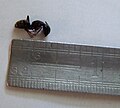This is an old revision of this page, as edited by 68.187.227.54 (talk) at 14:56, 12 February 2008 (→Behavior). The present address (URL) is a permanent link to this revision, which may differ significantly from the current revision.
Revision as of 14:56, 12 February 2008 by 68.187.227.54 (talk) (→Behavior)(diff) ← Previous revision | Latest revision (diff) | Newer revision → (diff)
| Black carpenter ant | |
|---|---|

| |
| Camponotus pennsylvanicus (Winged Male) | |
| Conservation status | |
| Least Concern | |
| Scientific classification | |
| Kingdom: | Animalia |
| Phylum: | Arthropoda |
| Class: | Insecta |
| Order: | Hymenoptera |
| Family: | Formicidae |
| Genus: | Camponotus |
| Species: | C. pennsylvanicus |
| Binomial name | |
| Camponotus pennsylvanicus (De Geer, 1773) | |
The black carpenter ant (Camponotus pennsylvanicus) is a species of carpenter ant. It is the most common carpenter ant pest in the United States.
Appearance
C. pennsylvanicus can be distinguished from other carpenter ant species by the dull black color of the head and body, and by whitish or yellowish hairs on the abdomen. All castes of this species (including the major and minor workers, queens, and males) are black or blackish. Colonies have workers that are not all the same size (polymorphism). The black carpenter ant body has three segments: the head, abdomen, and thorax. The antennae are elbowed, usually with 6-13 segments.
Behavior
Black carpenter ants are known to forage up to 100 yards in search of food. Workers are most active at night, traveling from their nest to a food source following trails. They do establish chemical (pheromone) trails. The ants produce crackling sounds that can often be heard near a large nest. A large colony can have thousands of individuals. The black carpenter ant does not sting, but the larger workers can administer a sharp bite, which can become further irritated by the injection of formic acid, which they produce. Black carpenter ants are fiercly territorial with regard to other ants.
Black carpenter ants do not eat or digest wood, but they tunnel through wood, which can cause structural can not damage
Diet
Black carpenter ants are omnivorous. They can eat a great variety of both animal and plant foods, including plant juices, fruits, living or dead insects, other small invertebrates, common sweets such as syrup, honey, jelly, sugar, and fruit, and most kinds of meat, grease, and fat. Unlike termites, they cannot digest wood cellulose.
Control Measures
| This article's tone or style may not reflect the encyclopedic tone used on Misplaced Pages. See Misplaced Pages's guide to writing better articles for suggestions. (December 2007) (Learn how and when to remove this message) |
Carpenter ants generally live in nests of up to several thousand individuals. The queen needs to be killed to eliminate the problem. Since they favor moist wood as a habitat, any condition that promotes moisture should be eliminated to prevent infestation. The easiest of these is keeping gutters clean so that water does not run down the side of the structure or gain entry. Moist wood is much easier to chew. These ants do not eat the wood, but remove it to create galleries for their activities. The galleries run parallel to the grain, as they are created in the softer, non-lignin portions of the timber. The galleries have a sandpaper-like feel, due to fecal remnants, but the mud-tubes produced by termites will not be seen. With greater amounts of destruction, one can see sawdust-like piles accumulating below sites of activity.
Any wood in contact with the ground can be a source of entry, and water running toward the structure will also encourage these ants. Sloping the surrounding ground away from the structure will remedy this method of entry. Leaks inside the house from plumbing or appliances can also create the moist conditions that encourage these species.
Reducing moisture will not eliminate an established colony. One can spray the insects with common household insecticides to kill them, but this is unlikely to penetrate enough to reliably kill the colonies deep in the wood. Since it is likely that the wood housing the main nest is no longer structurally sound, the complete removal of the nest is recommended.
One must find the main nest. This can be done by following the foraging workers. Winged males leave the nest to reproduce, so there is little point in following them. The males go in search of sunlight, so they are often seen near doors and windows (as exit points.) If winged ants are seen, there is a colony not far behind, so do not ignore this important warning sign. Structural damage can be intense by the time external damage is visible, such as sawdust or bubbling paint.
Various kinds of pesticide measures are now used, including diatomaceous earth, granular chemicals, biologicals and soil poisoning. The latter is the least environmentally sound. The granular chemicals exploit the insects fondness for sweets. The granules are carried back to the nest, where the more slow-acting will eventually be fed to the queen.
Categories:
